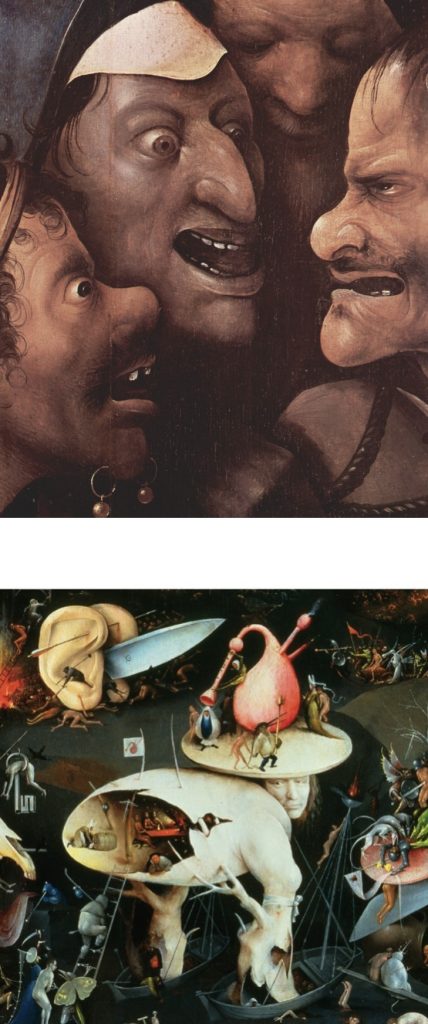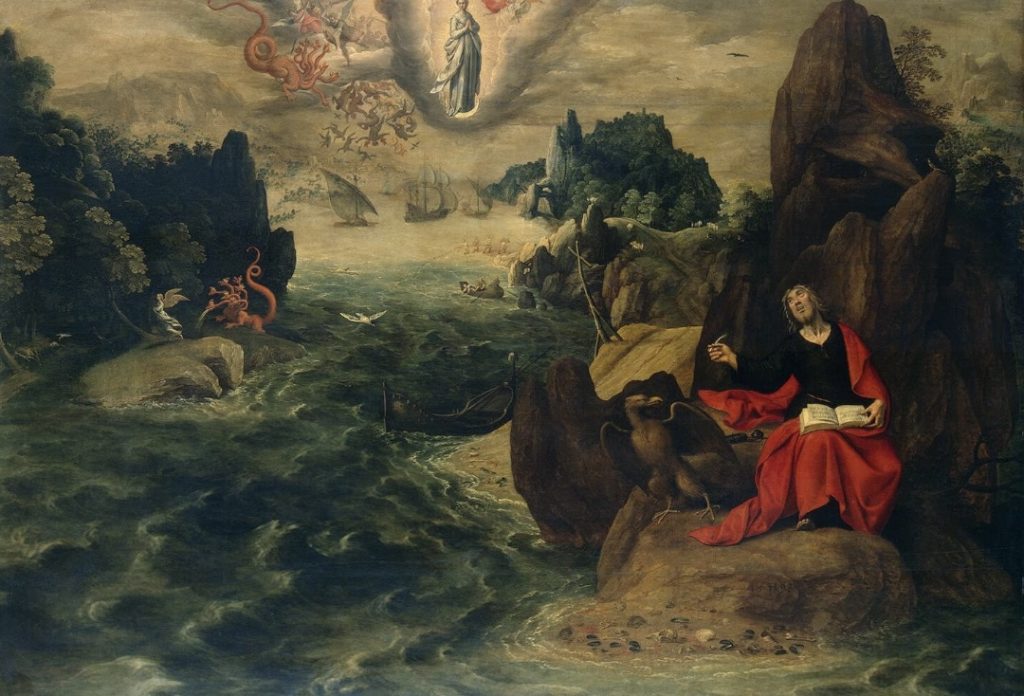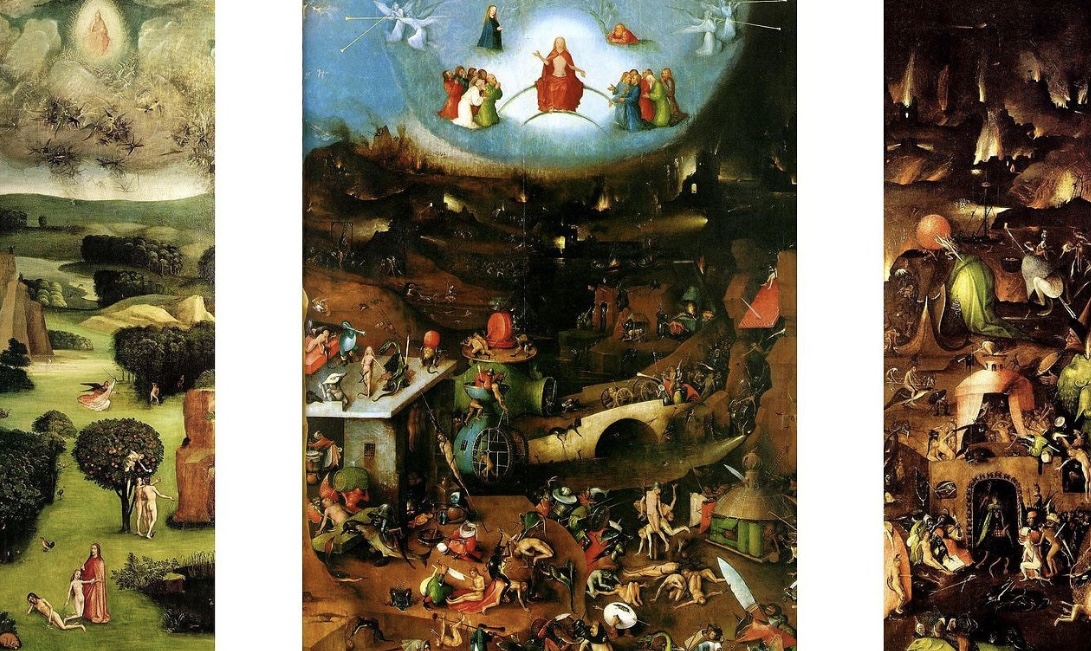HiErONYMus BOsCh
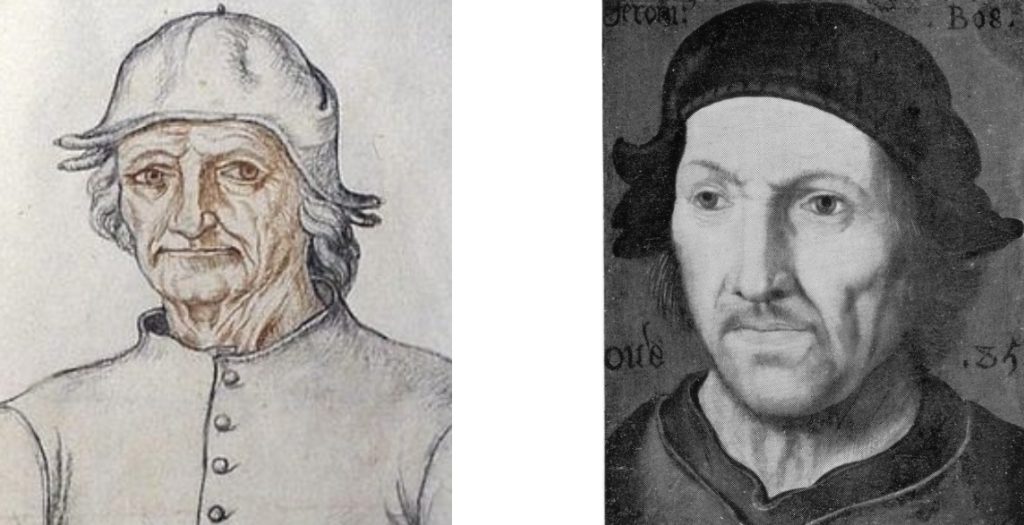
‘s-Hertogenbosch, Duchy of Brabant, Burgundian Netherlands Died (Buried) on 9 August 1516
Hieronymus Bosch was born Jheronimus (or Joen as respectively the Latin and Middle Dutch form of the name “Jerome”) van Aken (meaning “from Aachen”). He signed a number of his paintings as Jheronimus Bosch (pronounced Jeronimus Bos in Middle Dutch). The name derives from his birthplace, ‘s- Hertogenbosch, which is commonly called “Den Bosch”.
Little is known of Bosch’s life or training. He left behind no letters or diaries, and what has been identified has been taken from brief references to him in the municipal records of ‘s-Hertogenbosch, and in the account books of the local order of the Brotherhood of Our Lady. Nothing is known of his personality or his thoughts on the meaning of his art. Bosch’s date of birth has not been determined with certainty. It is estimated at c. 1450 on the basis of a hand drawn portrait (which may be a self-portrait) made shortly before his death in 1516. The drawing shows the artist at an advanced age, probably in his late sixties.

Bosch was born and lived all his life in and near ‘s-Hertogenbosch, a city in the Duchy of Brabant. His grandfather, Jan van Aken (died 1454), was a painter and is first mentioned in the records in 1430. It is known that Jan had five sons, four of whom were also painters. Bosch’s father, Anthonius van Aken (died c. 1478), acted as artistic adviser to the Brotherhood of Our Lady. It is generally assumed that either Bosch’s father or one of his uncles taught the artist to paint, but none of their works survive. Bosch first appears in the municipal record on 5 April 1474, when he is named along with two brothers and a sister.
‘s-Hertogenbosch was a flourishing city in fifteenth century Brabant, in the south of the present-day Netherlands, at the time part of the Burgundian Netherlands, and during his lifetime passing through royal marriage to the Habsburgs.
In 1463, 4,000 houses in the town were destroyed by a catastrophic fire, which the then (approximately) 13-year-old Bosch presumably witnessed. He became a popular painter in his lifetime and often received commissions from abroad. In 1488 he joined the highly respected Brotherhood of Our Lady, an arch-
conservative religious group of some 40 influential citizens of ‘s-Hertogenbosch, and 7,000 ‘outer-members’ from around Europe.
Sometime between 1479 and 1481, Bosch married Aleyt Goyaerts van den Meerveen, who was a few years older than the artist. The couple moved to the nearby town of Oirschot, where his wife had inherited a house and land from her wealthy family.
An entry in the accounts of the Brotherhood of Our Lady records Bosch’s death in 1516. A funeral mass served in his memory was held in the church of Saint John on 9 August of that year.
.
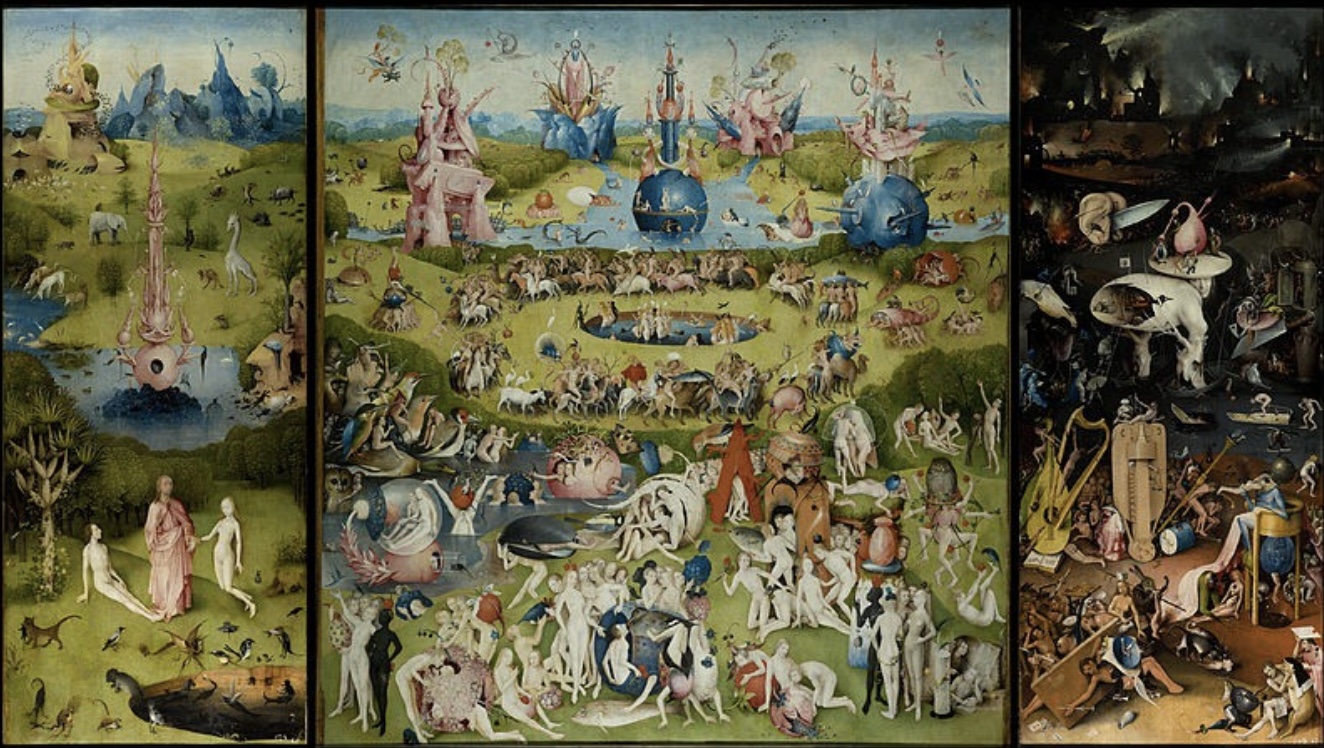
Bosch produced several triptychs. Among his most famous is The Garden of Earthly Delights. This painting, for which the original title has not survived, depicts paradise with Adam and Eve and many wondrous animals on the left panel, the earthly delights with numerous nude figures and tremendous fruit and birds on the middle panel, and hell with depictions of fantastic punishments of the various types of sinners on the right panel. When the exterior panels are
closed the viewer can see, painted in grisaille, God creating the Earth. These paintings—especially the Hell panel—are painted in a comparatively sketchy manner which contrasts with the traditional Flemish style of paintings, where the smooth surface—achieved by the application of multiple transparent glazes— conceals the brushwork. In this painting, and more powerfully in works such as his Temptation of St. Anthony, Bosch draws with his brush. Bosch also produced some of the first autonomous sketches in Northern Europe.
Bosch never dated his paintings. But—unusual for the time—he seems to have signed several of them, although some signatures purporting to be his are certainly not. Fewer than 25 paintings remain today that can be attributed to him. In the late sixteenth-century, Philip II of Spain acquired many of Bosch’s paintings, including some probably commissioned and collected by Spaniards active in Bosch’s hometown; as a result, the Prado Museum in Madrid now owns The Adoration of the Magi, The Garden of Earthly Delights, the tabletop painting of The Seven Deadly Sins and the Four Last Things, the Haywain Triptych and The Stone Operation.
The Haywain Triptych was part of a group of six acquired by king Philip II of Spain in 1570, and shipped to El Escorial four years later. It was later sold to the Marquis of Salamanca, and divided into three paintings. In 1848, the central panel was bought by Isabella II of Spain and brought to Aranjuez, the right one was returned to Escorial and the left went to the Prado. The triptych was finally recomposed in 1914 in the latter museum.
The Haywain triptych follows a similar narrative to The Garden of Earthly Delights. The left panel shows God giving form to Eve. Unlike the Garden, though, a narrative sequence flows through the panel in different scenes. At the top, the rebel angels are cast out of Heaven while God sits enthroned, the angels turning into insects as they break through the clouds. Below this, God creates Eve from the rib of Adam. Next, Adam and Eve find the serpent and the tree; the serpent offers them an apple. Finally, at the lowest part of the panel, Angel Gabriel forces the two out of the Garden of Eden. Adam speaks with the angel; Eve, in a melancholic pose, looks ahead to the right.
The central panel features a large wagon of hay surrounded by a multitude of fools engaged in a variety of sins, quite apart from the sins of lust which dominates the Garden of Earthly Delights. In the center panel, Bosch shows Christ in the sky, not paralleled in the Garden. An angel on top of the wagon
looks to the sky, praying, but none of the other figures see Christ looking down on the world. The rightward bow of the figures around the wagon provides the force for the viewer’s eye to move with them on their journey and the cart is drawn by infernal beings which drag everyone to Hell, depicted on the right panel.
The forward kinetic motion of the participants moves the viewer from present- day sin into unadulterated torture in the realms of Hell. The procession on the left side of this panel bends back into the middle ground, but the right side figures continue in a straight line with the wagon, a more evident progress into damnation.
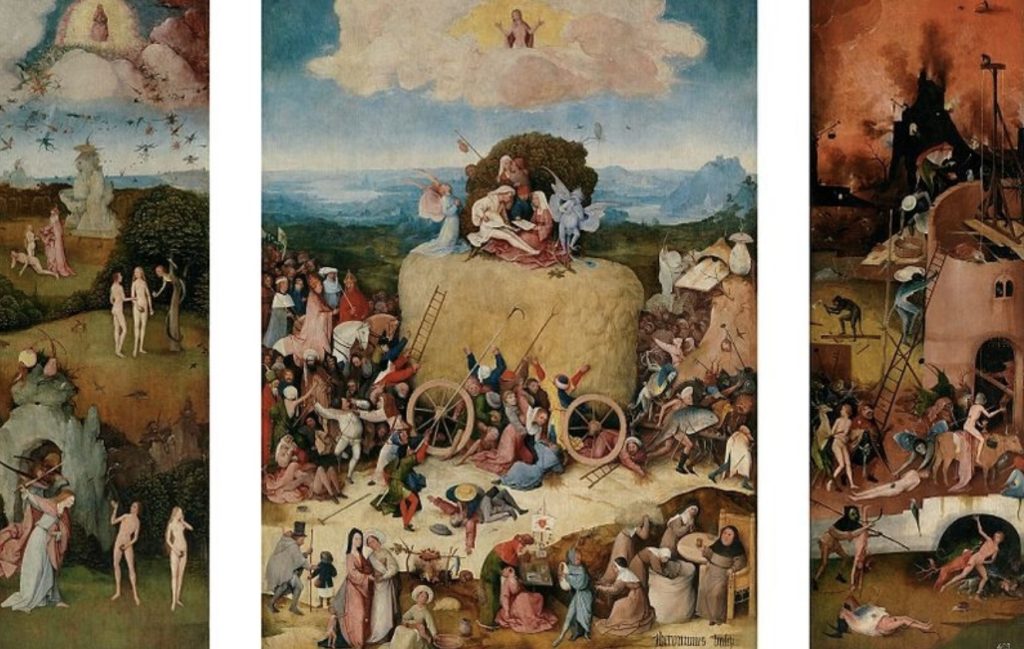
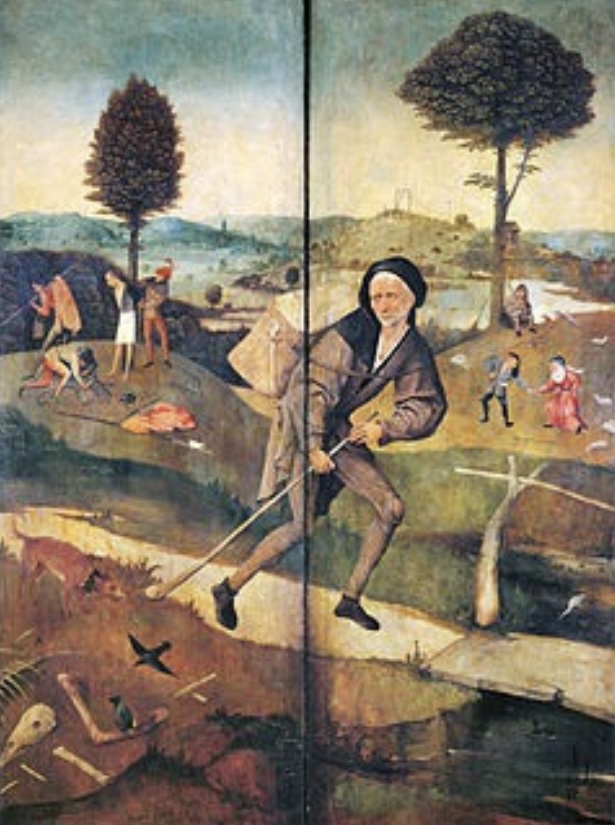
In the twentieth century, when changing artistic tastes made artists like Bosch more palatable to the European imagination, it was sometimes argued that Bosch’s art was inspired by heretical points of view (e.g., the ideas of the Cathars and putative Adamites) as well as by obscure hermetic practices. Again, since Erasmus had been educated at one of the houses of the Brethren of the Common Life in ‘s-Hertogenbosch, and the town was religiously progressive, some writers have found it unsurprising that strong parallels exist between the caustic writing of Erasmus and the often bold painting of Bosch. Although the Brethren remained loyal to the Pope, they still saw it as their duty to denounce the abuses and scandalous behavior of many priests: the corruption which both Erasmus and Bosch satirized in their work.
Others, following a strain of Bosch-interpretation datable already to the sixteenth-century, continued to think his work was created merely to titillate and amuse, much like the “grotteschi” of the Italian Renaissance. While the art of the older masters was based in the physical world of everyday experience, Bosch confronts his viewer with, in the words of the art historian Walter Gibson, “a
world of dreams [and] nightmares in which forms seem to flicker and change before our eyes”. In one of the first known accounts of Bosch’s paintings, in 1560 the Spaniard Felipe de Guevara wrote that Bosch was regarded merely as “the inventor of monsters and chimeras”. In the early seventeenth century, the Dutch art historian Karel van Mander described Bosch’s work as comprising “wondrous and strange fantasies”; however, he concluded that the paintings are “often less pleasant than gruesome to look at”.
.
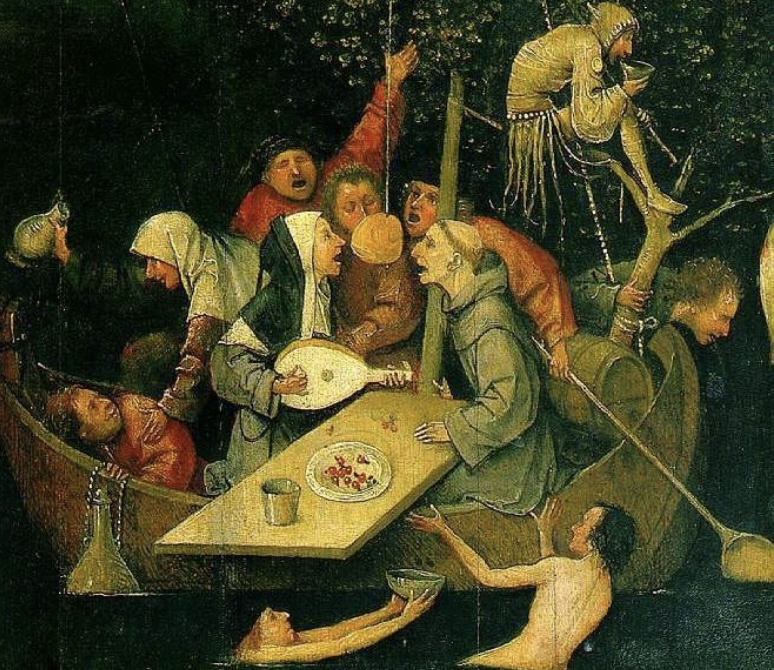
In recent decades, scholars have come to view Bosch’s vision as less fantastic, and accepted that his art reflects the orthodox religious belief systems of his age. His depictions of sinful humanity and his conceptions of Heaven and Hell are now seen as consistent with those of late medieval didactic literature and sermons. Most writers attach a more profound significance to his paintings than had previously been supposed, and attempt to interpret it in terms of a late medieval morality. It is generally accepted that Bosch’s art was created to teach specific moral and spiritual truths in the manner of other Northern Renaissance figures, such as the poet Robert Henryson, and that the images rendered have precise and premeditated significance. According to Dirk Bax, Bosch’s paintings often represent visual translations of verbal metaphors and puns drawn from both biblical and folkloric sources.[12] However, the conflict of interpretations
that his works still elicit raise profound questions about the nature of “ambiguity” in art of his period.
In recent years, art historians have added a further dimension again to the subject of ambiguity in Bosch’s work. They emphasized his ironic tendencies, which are fairly obvious, for example, in the The Garden of Earthly Delights, both in the central panel (delights),[13] and the right panel (hell).[14] By adding irony to his morality arenas, Bosch offers the option of detachment, both from the real world and from the painted fantasy world. By doing so he could gain acceptance among both conservative and progressive viewers. Perhaps it was just this ambiguity that enabled the survival of a considerable part of this provocative work through five centuries of religious and political upheaval.
A recent study on Bosch’s paintings alleges that they actually conceal a strong nationalist consciousness, censuring the foreign imperial government of the Burgundian Netherlands, especially Maximilian Habsburg. By systematically superimposing images and concepts, the study asserts that Bosch also made his expiatory self-punishment, for he was accepting well-paid commissions from the Habsburgs and their deputies, and therefore betraying the memory of Charles the Bold.
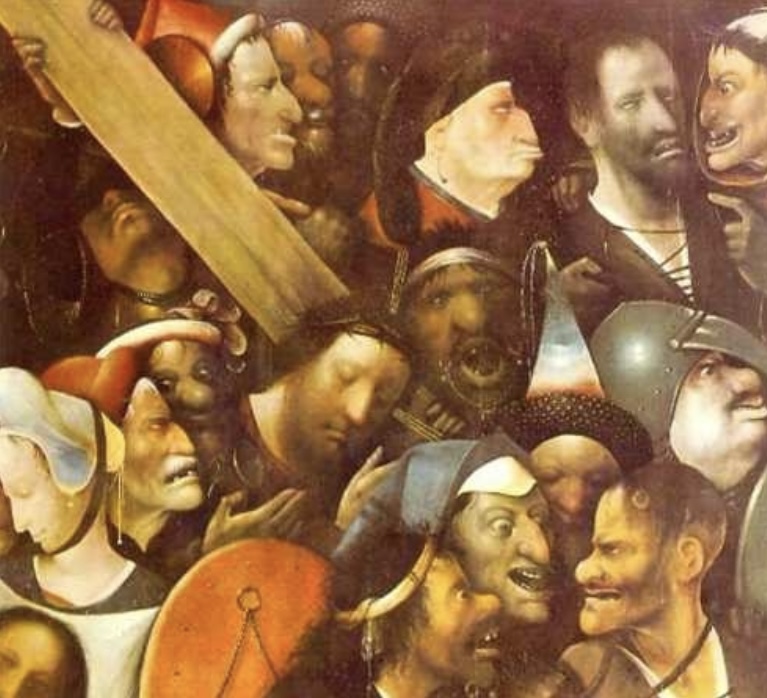
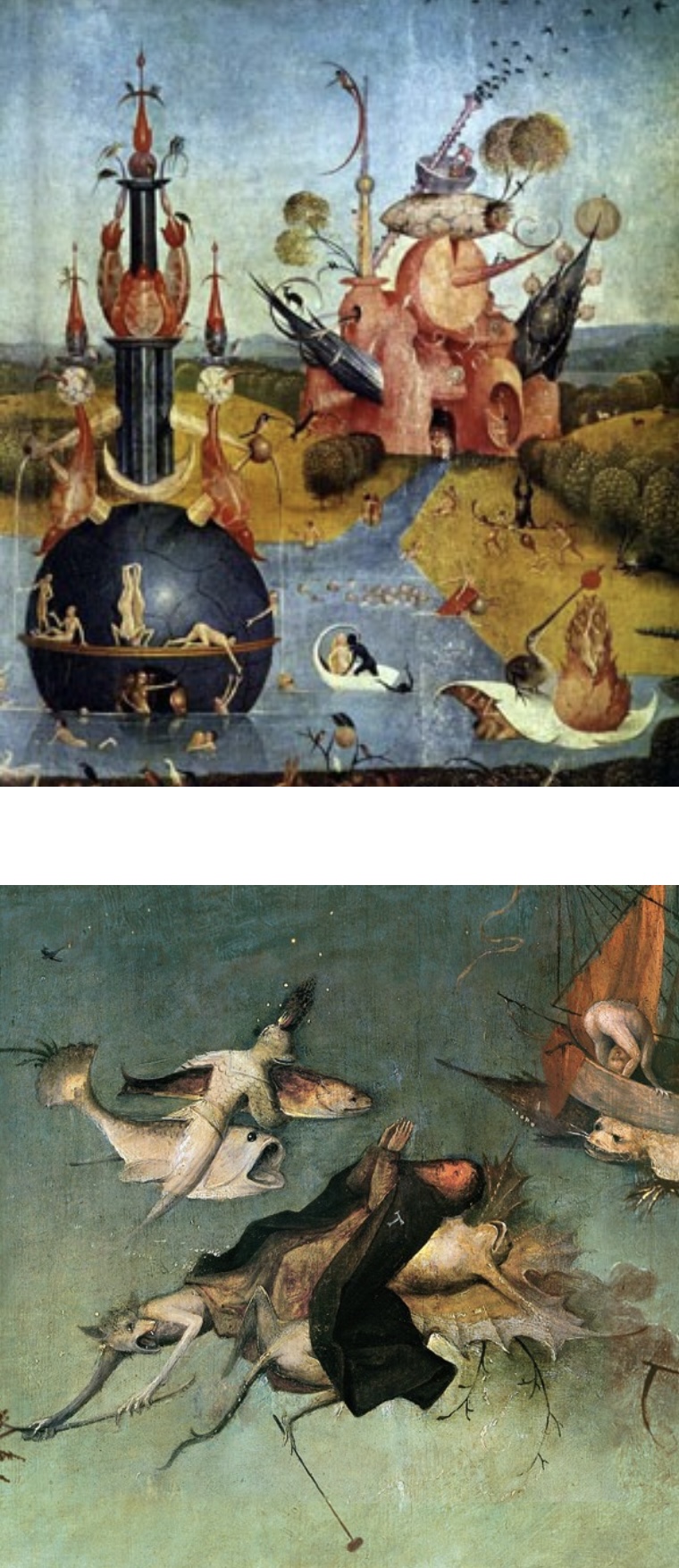
The exact number of Bosch’s surviving works has been a subject of considerable debate. He signed only seven of his paintings, and there is uncertainty whether all the paintings once ascribed to him were actually from his hand. It is known that from the early sixteenth century onwards numerous copies and variations of his paintings began to circulate. In addition, his style was highly influential, and was widely imitated by his numerous followers.
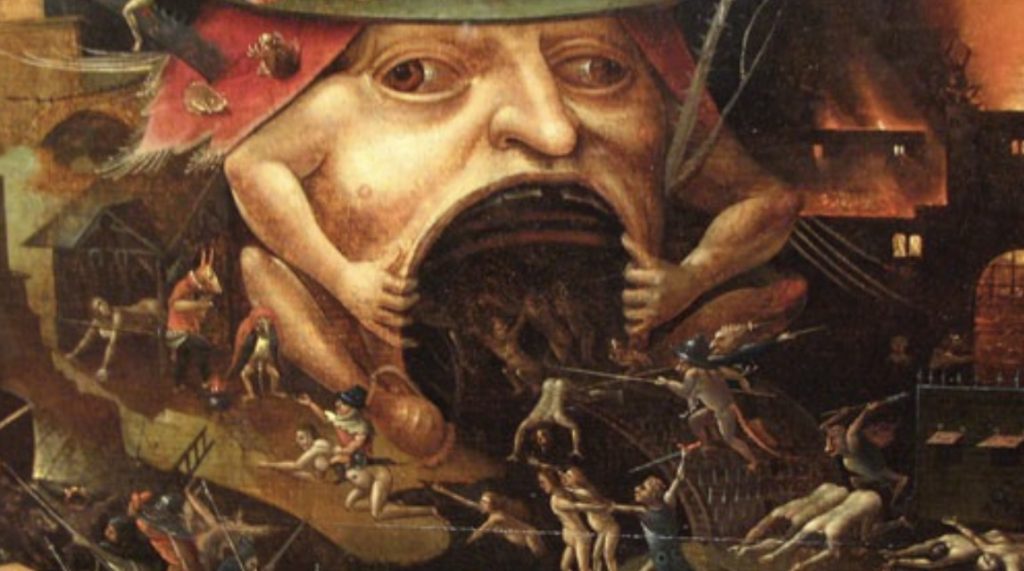
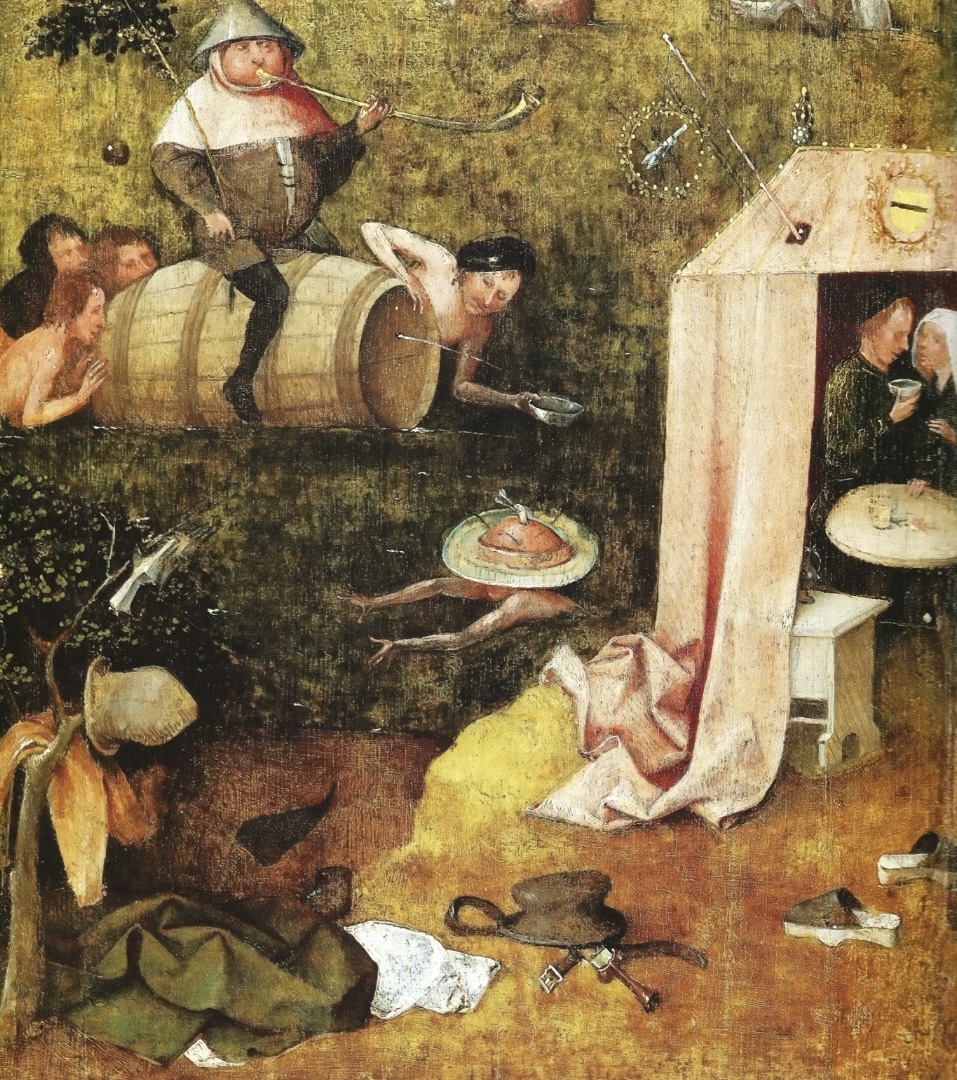
Over the years, scholars have attributed to him fewer and fewer of the works once thought to be his, and today only 25 are definitively attributed to him.
Allegory of Gluttony and Lust is a Hieronymus Bosch painting made sometime between 1490 and 1500. It is currently in the Yale University Art Gallery in New Haven, Connecticut.
This panel is the left inside bottom wing of a hinged triptych. The other identified parts are The Ship of Fools, which formed the upper left panel and the Death and the Miser, which was the right panel; The Wayfarer was painted on the right panel rear. The central panel, if existed, is unknown.
The Allegory represented a condemnation of gluttony, in the same way the right panel condemned avarice. The fragment shows a fat man riding a barrel in a kind of lake or pool. He is surrounded by other people, who push him or pour a liquid from the barrel. Below, a man swims with, above his head, a vessel with meat. The swimmer’s clothes lie on the shore at bottom. On the right, under a hut, a couple is devoting to lascivious acts, perhaps induced by drunkenness.
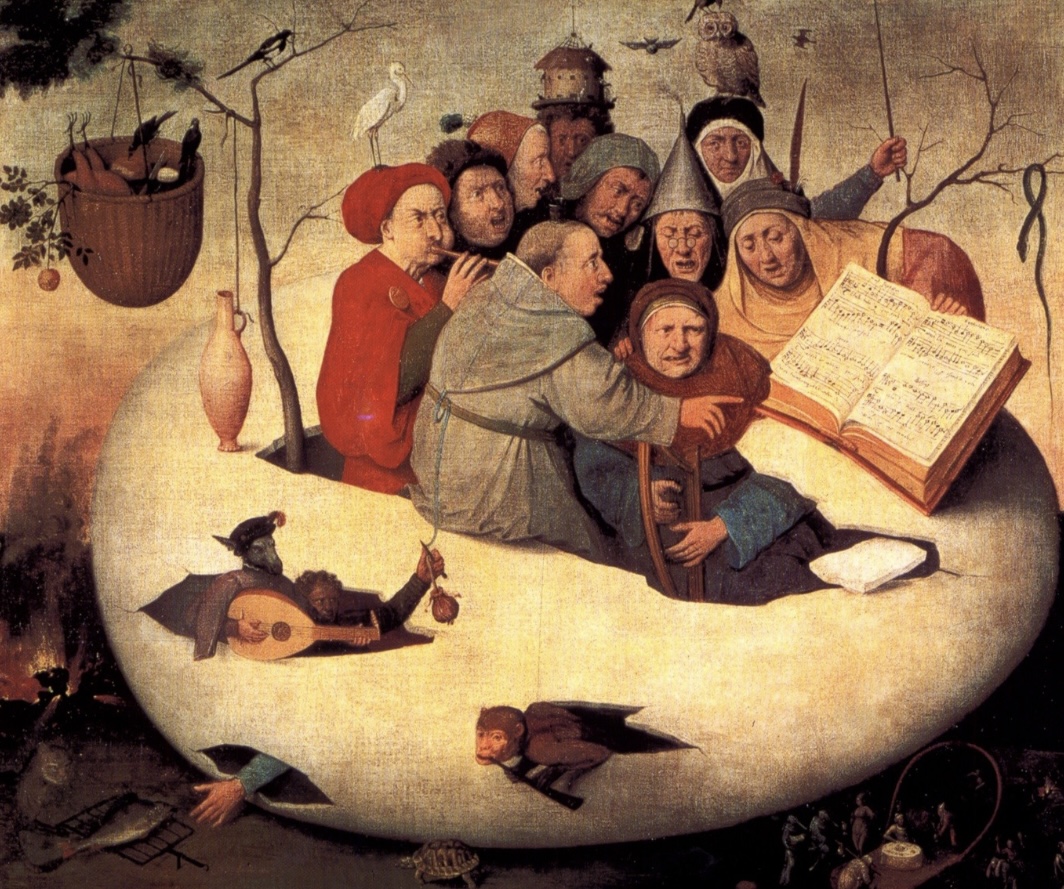
The group of singers form the “yolk” of the egg, which symbolizes “fool” as in “yokel”. The eel resembles a form of beer (ale). The scene is reminiscent of the similar Ship of Fools (painting). One of the singers is so intent on his song (pointing towards the book) that he doesn’t notice that he is being robbed by the lute player.
Modern attribution of the painting (to an as yet anonymous follower of Bosch) was based on an analysis of the music in the open book, which shows notes by Thomas Crecquillon from 1549. The work was bought in 1890 for 400 francs by the Palais des Beaux-Arts de Lille from Morhange, a parisian art dealer. It was featured with the Dutch title “Zangers en Musici in een Ei” in an exhibition in 2008 at the Noordbrabants Museum, ‘s-Hertogenbosch, the Netherlands.
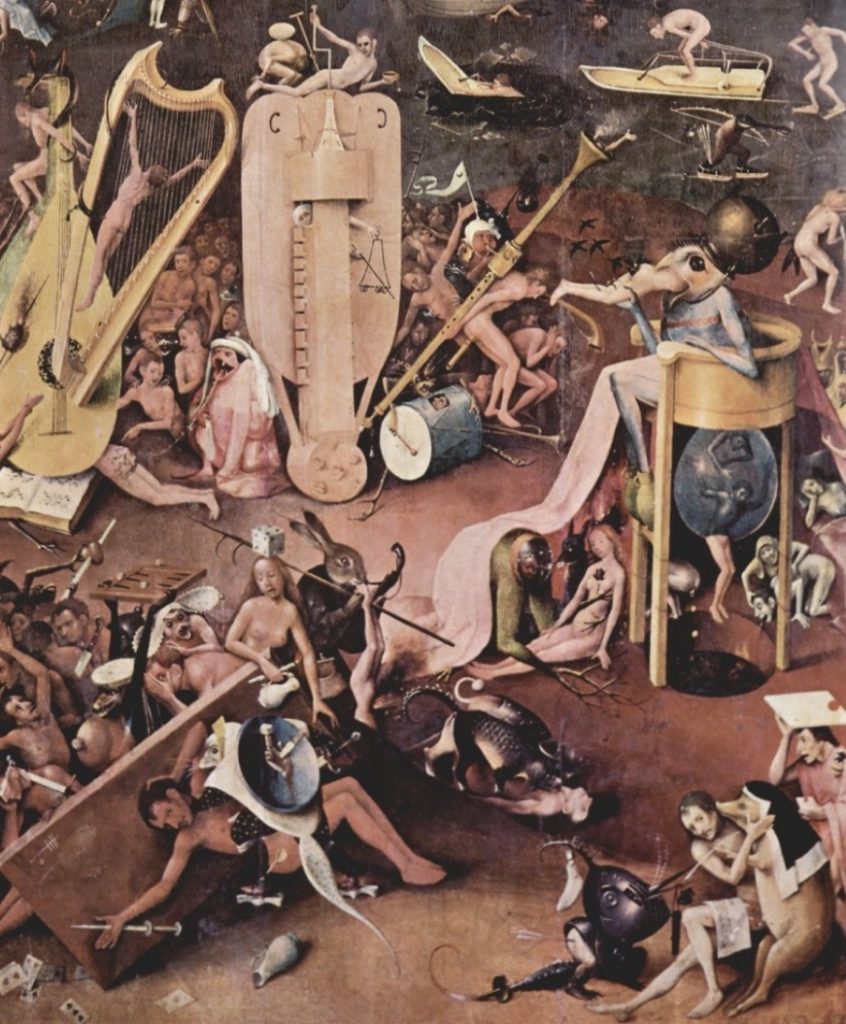
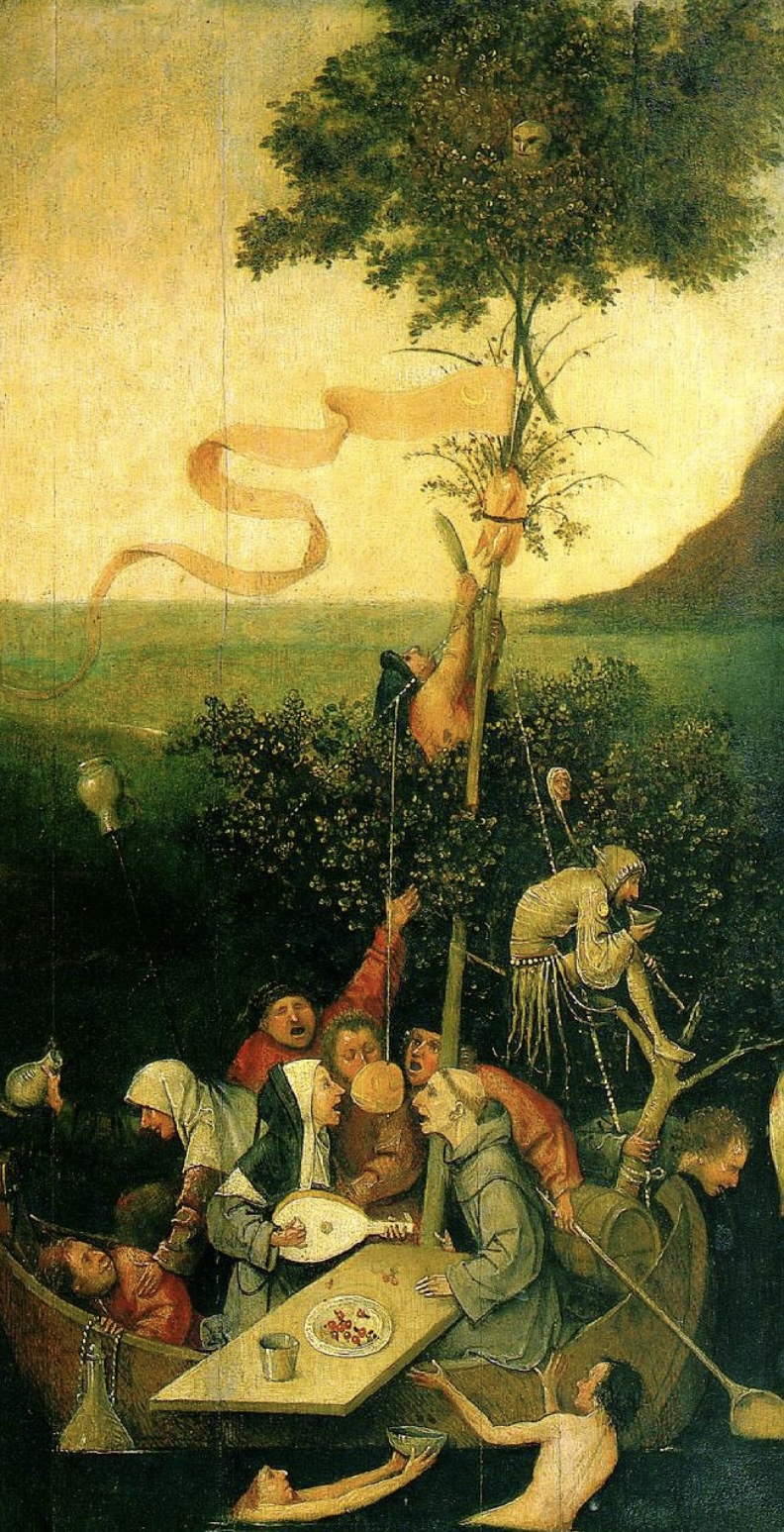
1490-1500, Musee du Louvre, Paris, France
“Ship of Fools” now on display in the Musée du Louvre, Paris. The painting is dense in symbolism and is indebted to, if not actually satirical of Albrecht Dürer’s frontispiece of Sebastian Brant’s book of the same name.
The painting as we see it today is a fragment of a triptych that was cut into several parts. The Ship of Fools was painted on one of the wings of the altarpiece, and is about two thirds of its original length. The bottom third of the panel belongs to Yale University Art Gallery and is exhibited under the title Allegory of Gluttony. The wing on the other side, which has more or less retained its full length, is the Death and the Miser, now in the National Gallery of Art, Washington, D.C. The two panels together would have represented the two extremes of prodigiality and miserliness, condemning and caricaturing both.
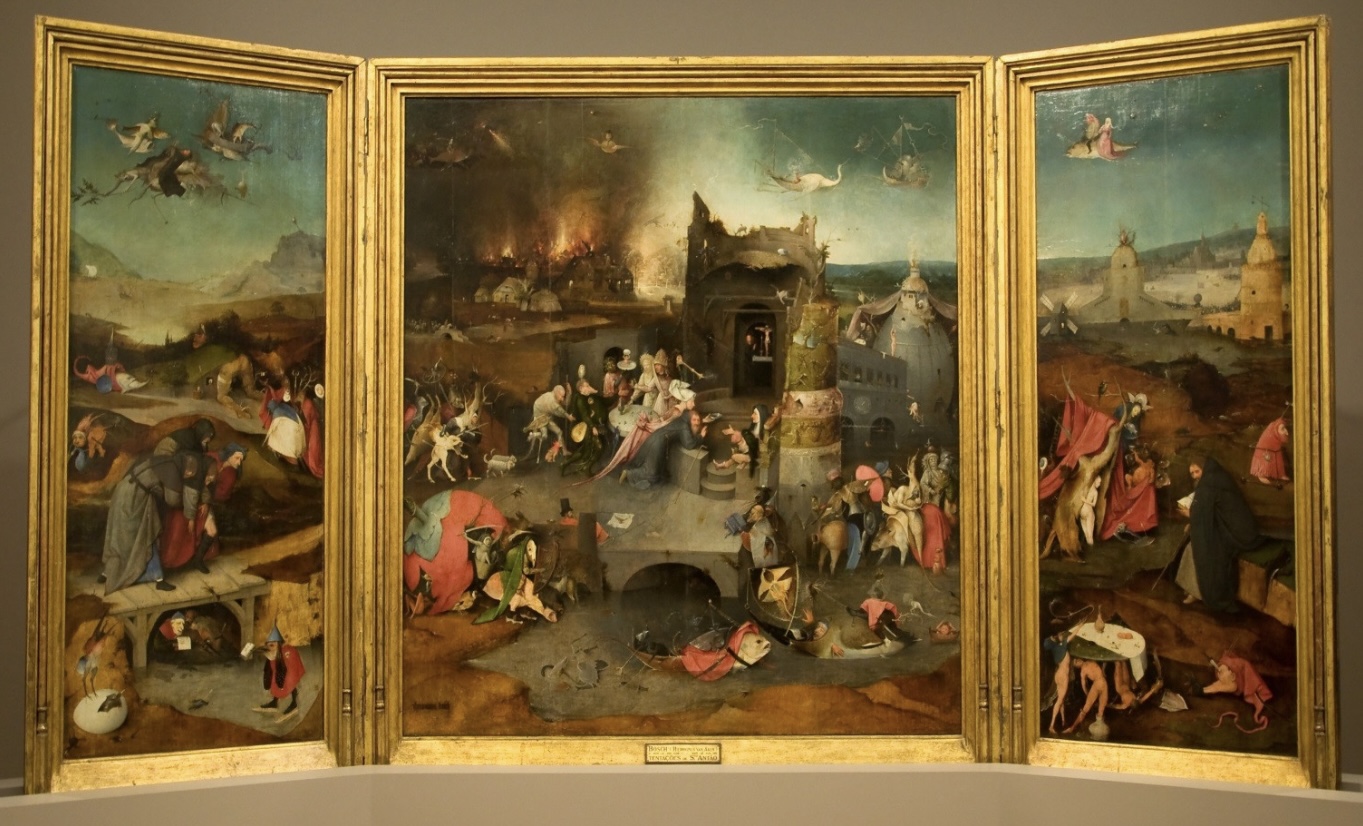
The Triptych of “Temptation of St. Anthony” is an oil painting on wood panels by Flemish artist Hieronymus Bosch, dating from around 1501. The work tells the story of the mental and spiritual torments endured by Saint Anthony the
Great (Anthony Abbott), one of the most prominent of the Desert Fathers of Egypt in the late 3rd and early 4th centuries. The Temptation of St Anthony was a popular subject in Medieval and Renaissance art. In common with many of Bosch’s work, the triptych contains much fantastic imagery. The painting hangs in the Museu Nacional de Arte Antiga, in Lisbon, Portugal.
The work tells symbolically the story of the mental and spiritual torments endured by St. Anthony Abbott throughout his life. The sources for the subjects were Athanasius of Alexandria’s Life of St. Anthony, which had been popularized in the Flanders by Pieter van Os, and Jacopo da Varazze’s “Golden Legend.”
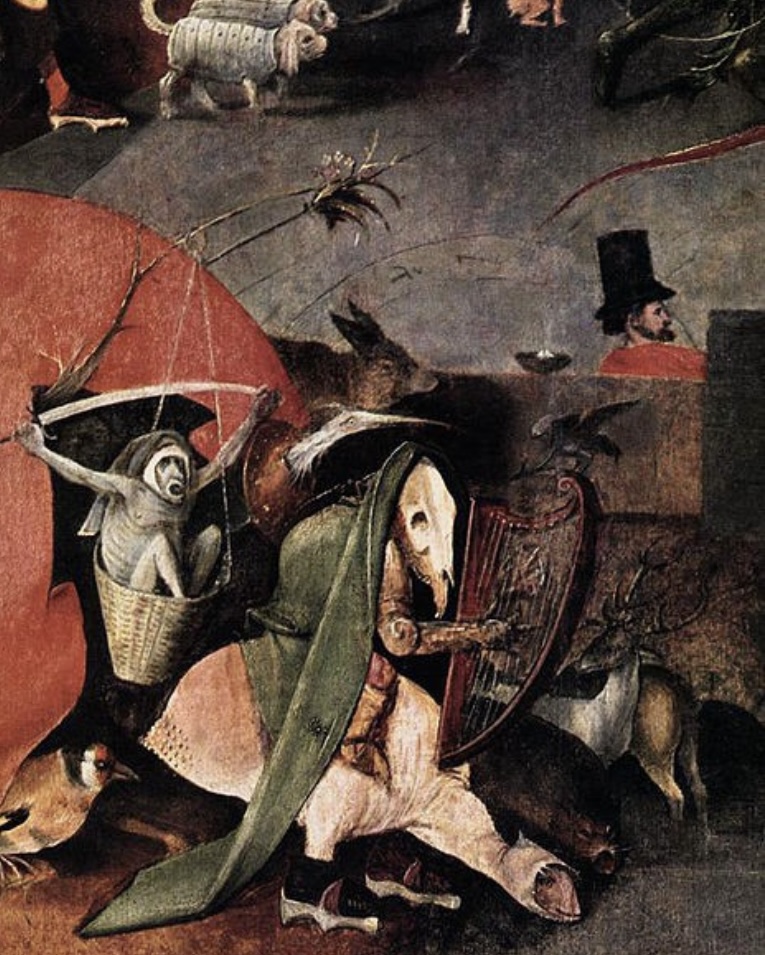
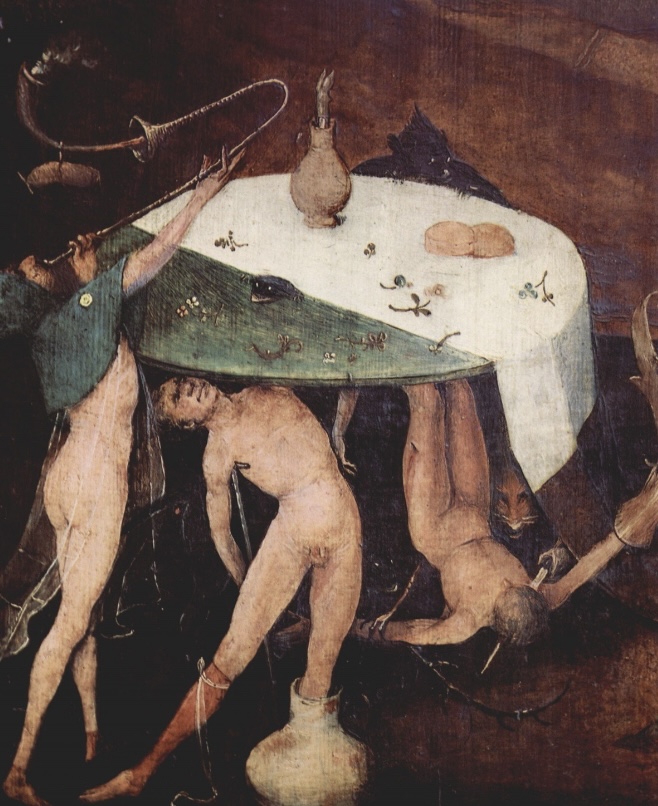
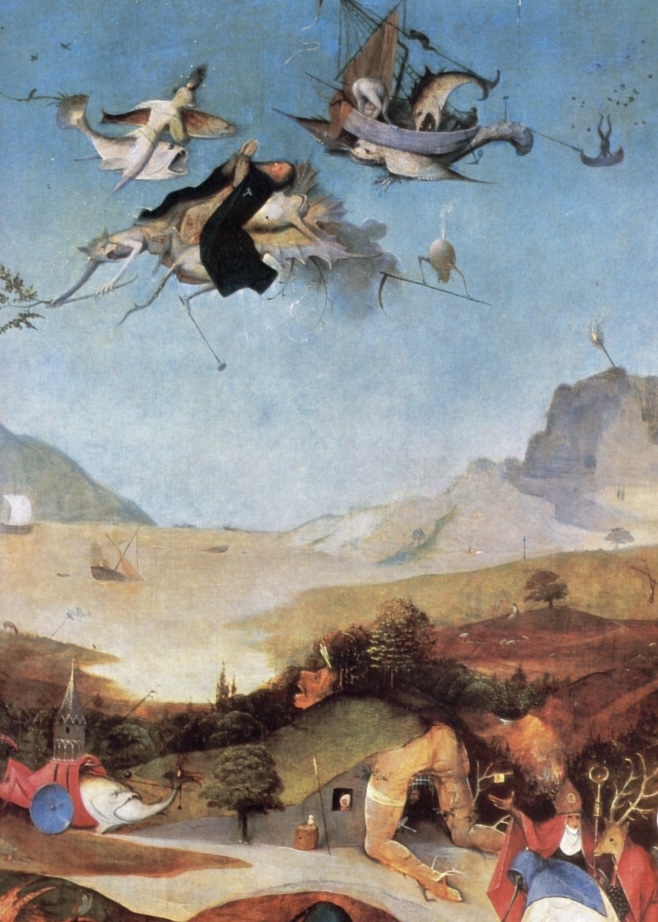
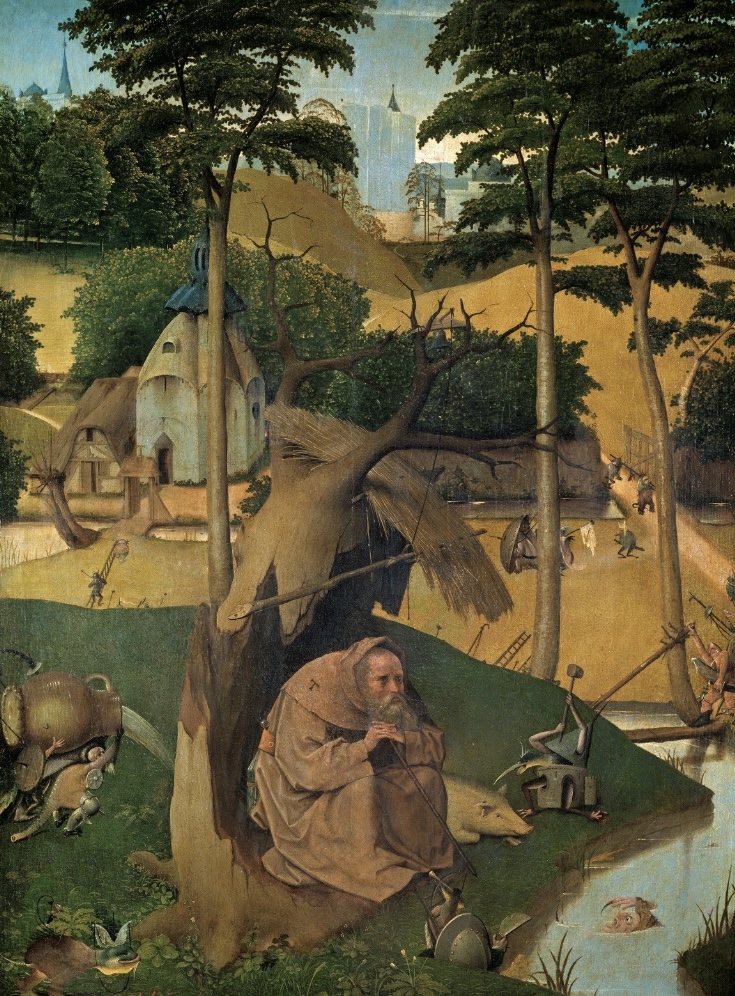
Here, St. Anthony the Abbot is portrayed in meditation, in a sunny landscape near the trunk of a dry tree. St. Anthony is a recurrent figure in Bosch’s work, with up to 15 paintings of this subject, all inspired by legends told in the Golden Legend and in his Life by Athanasius of Alexandria. He is represented in a setting of solitude and temptation that the saint experienced over twenty years. Although this picture is significantly different from other works by Bosch of St. Anthony, such as the triptych painting of the same name, customary features of the abbot include the his dark brown habit with the Greek letter “tau” and pig by his side.
In contrast to the earlier paintings with St. Anthony, this version of The Temptation of St. Anthony finds the abbot calmer from his meditative spirit. His surroundings are peaceful and evoke a sense of calm. The pig lies next to him
like a pet. Once demons, the creatures of temptation are now more like goblins and do not disturb the peaceful feeling of the painting.
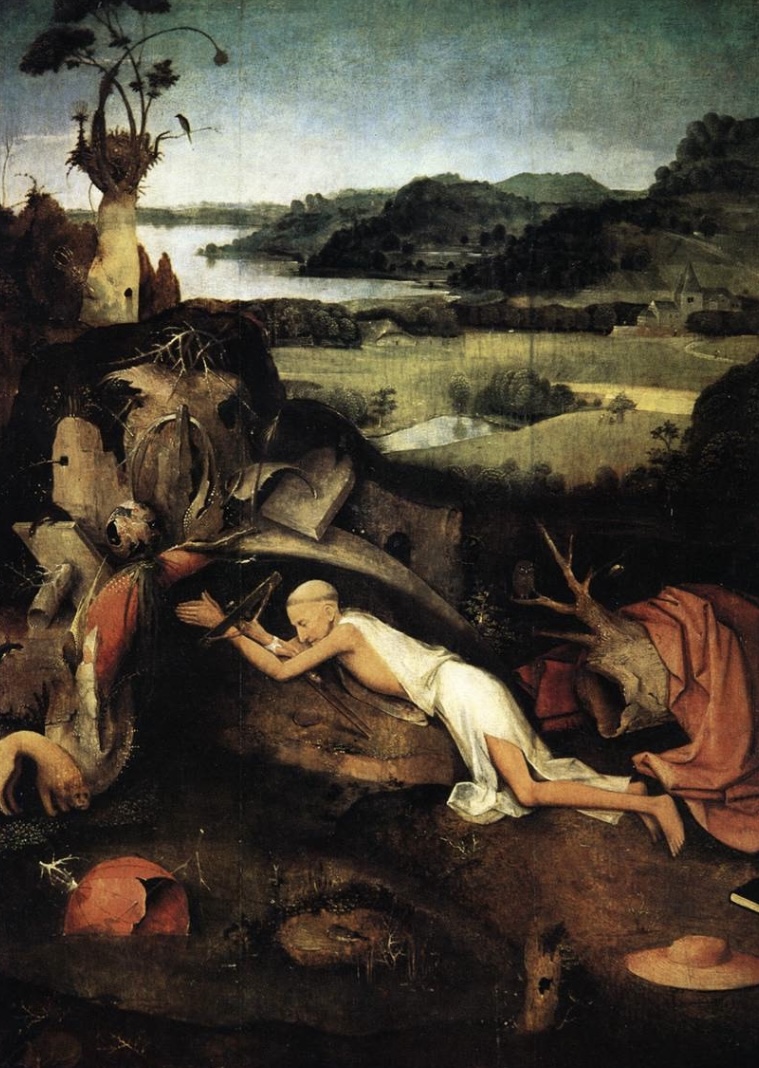
St. Jerome was a frequent subject of 15th century European art, depicted in his studio or during his penitence in the desert. Bosch for this picture adopted the latter iconography, although his saint is prone instead of kneeling. He is praying with a crucifix in his arms, also an unusual gesture of communion with Christ.
Jerome lies on a rock located under a kind of shell-like cave. He is surrounded by his traditional symbols (the lion – although in this case it has a smaller size
than usual – the galero, the Bible), but Bosch, as common in his works, also added some bizarre elements, such as the bony pig or the spherical shell emerging from the pool . This could symbolize the world floating towards decay.
Am owl and little owl are depicted on a branch: they allude, respectively, to heresy and the struggle against heresy. The Ten Commandments tables can be seen above the cave. The landscape is wide, in green tones.
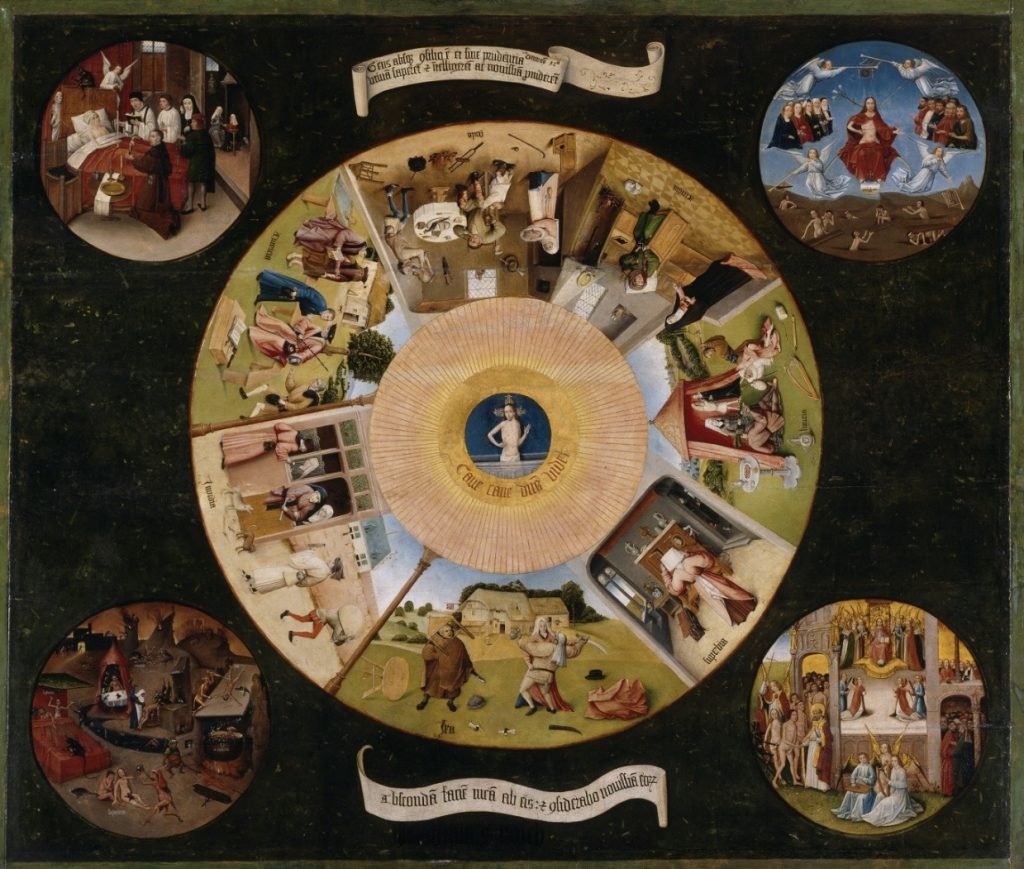
1500) in Museo del Prado, Madrid
SEvEN DEadlY SiNs
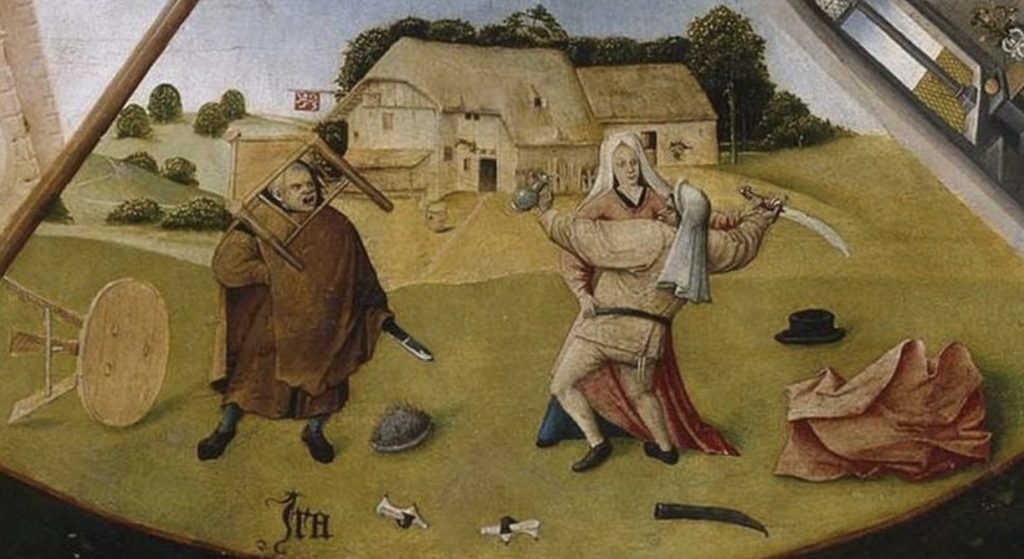
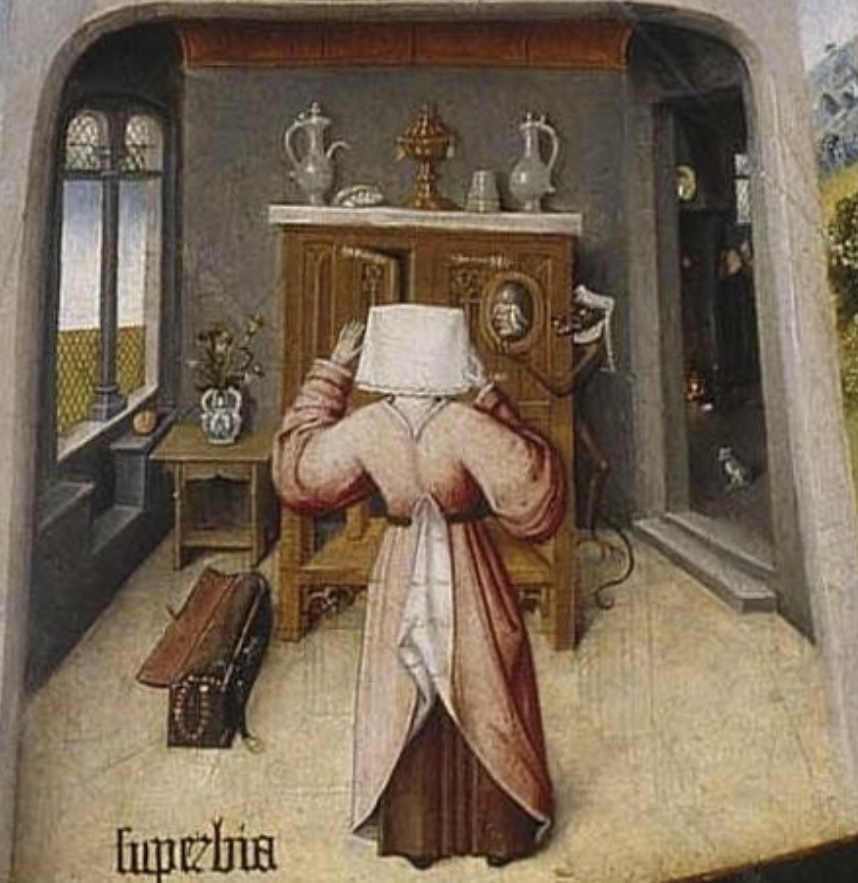
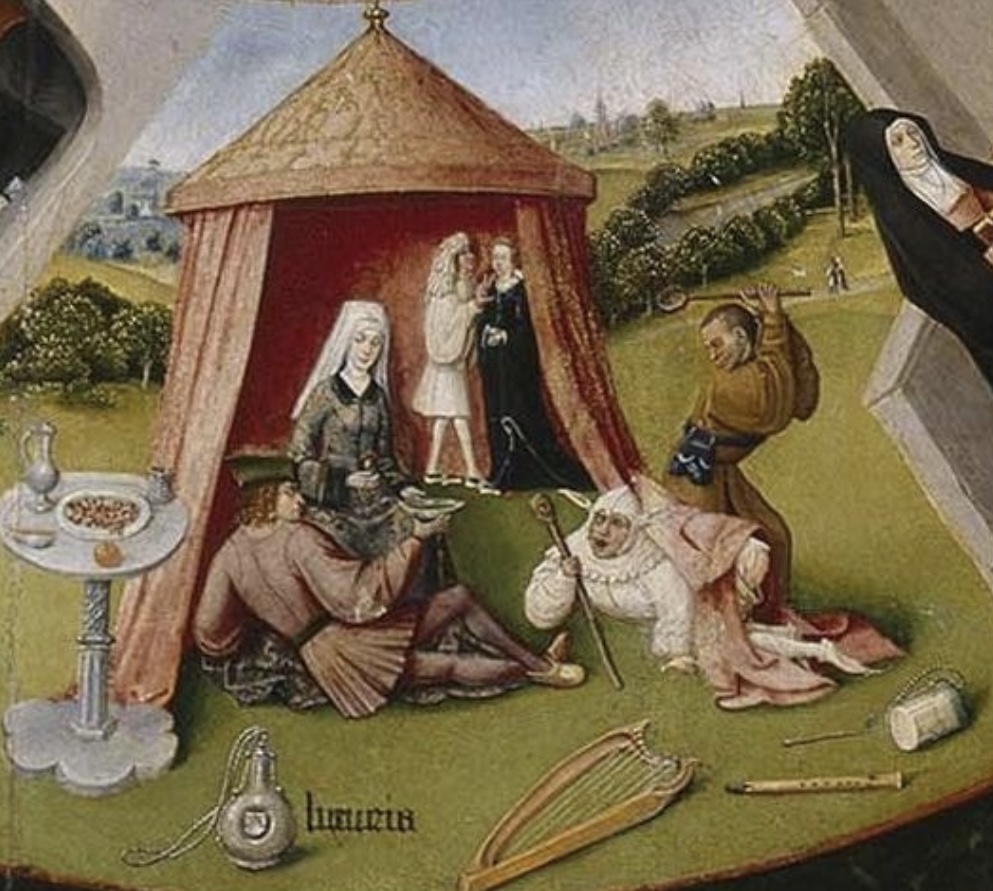
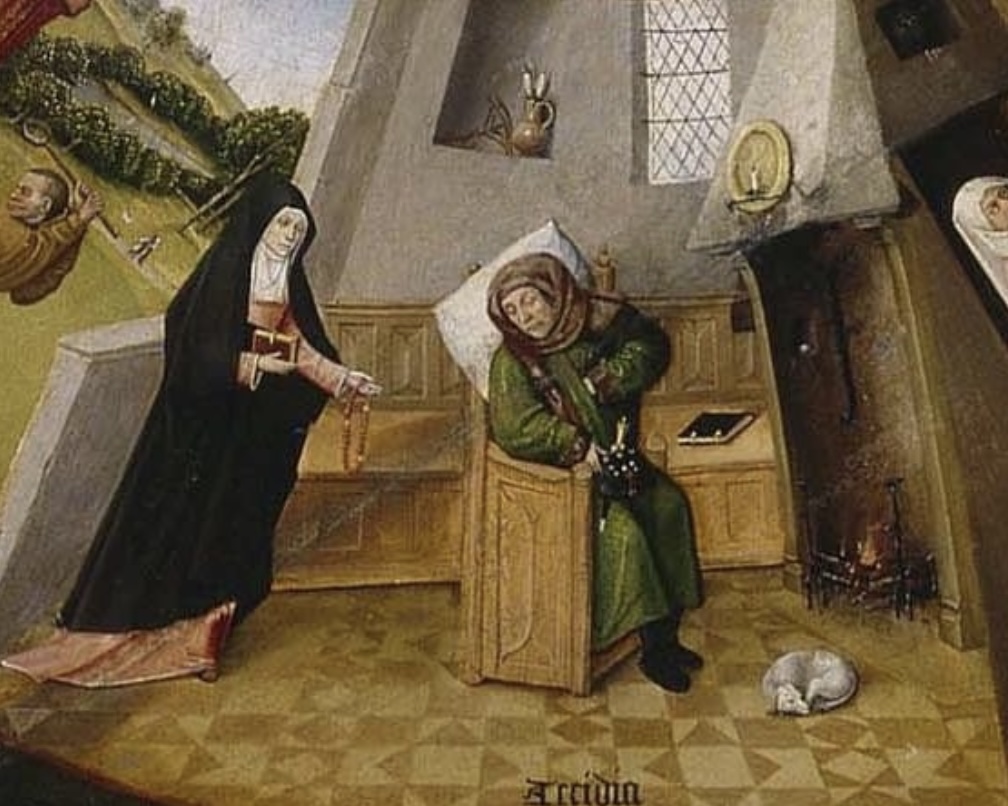
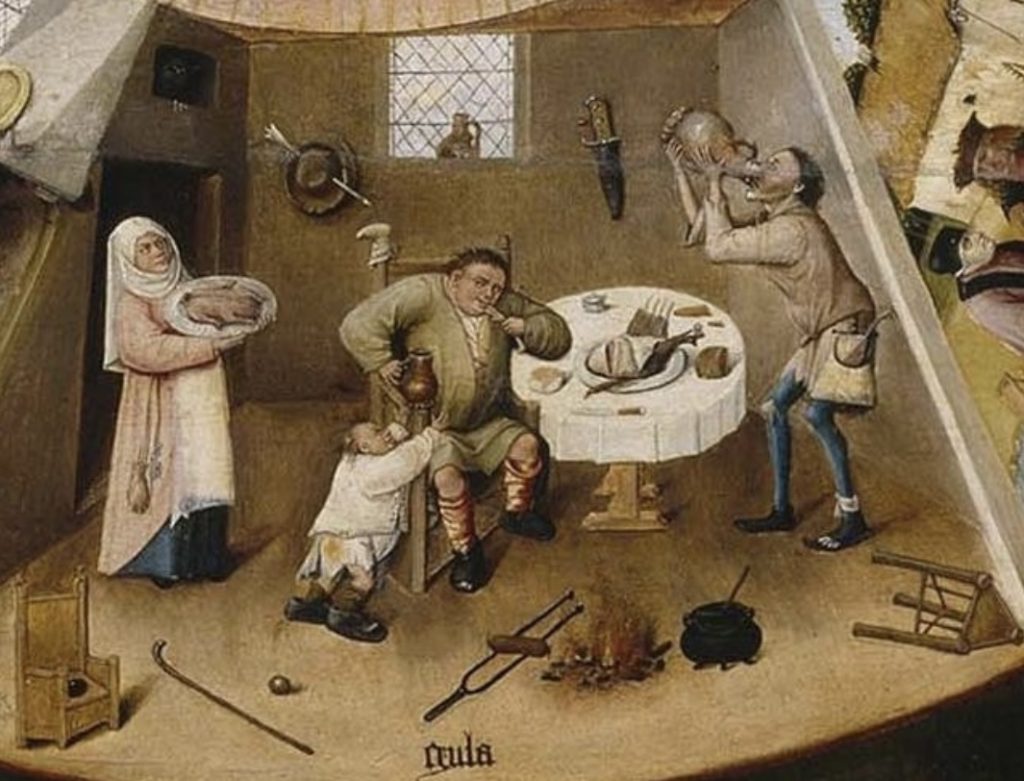
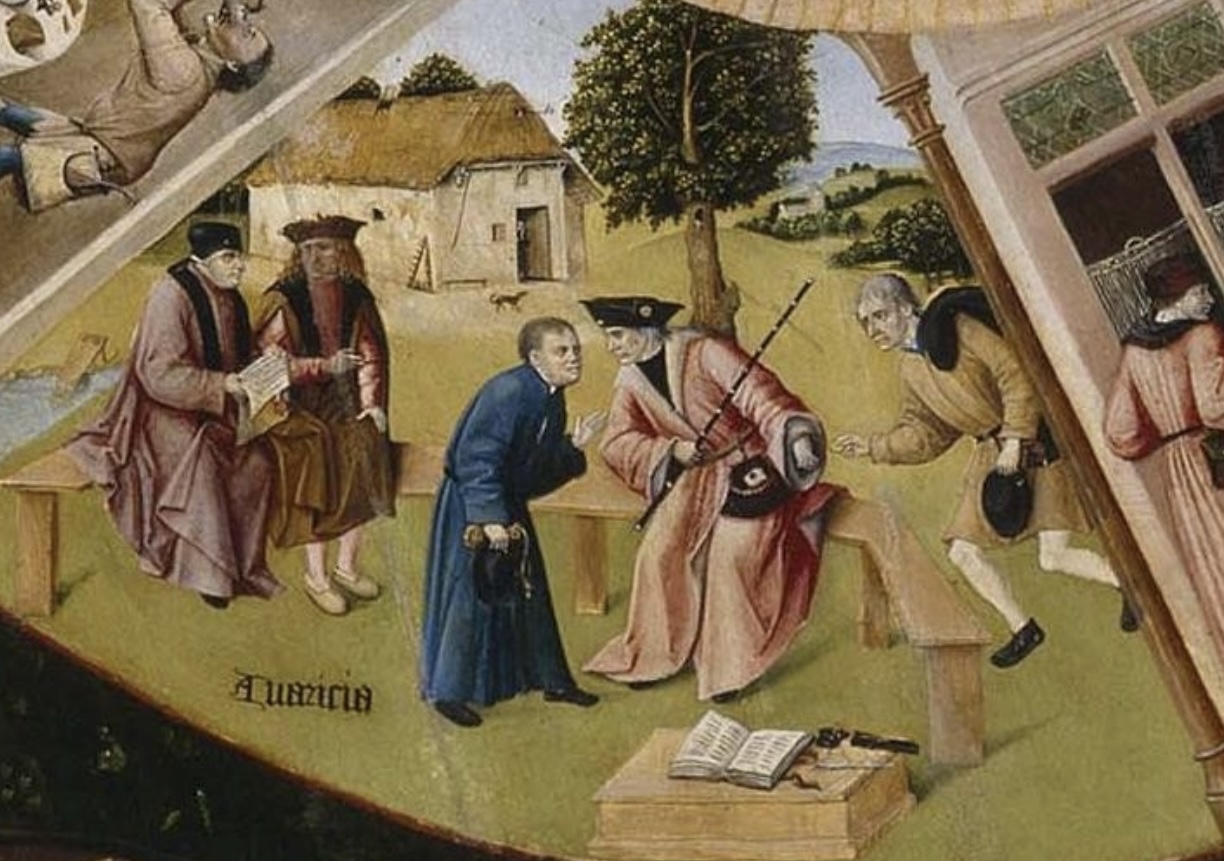
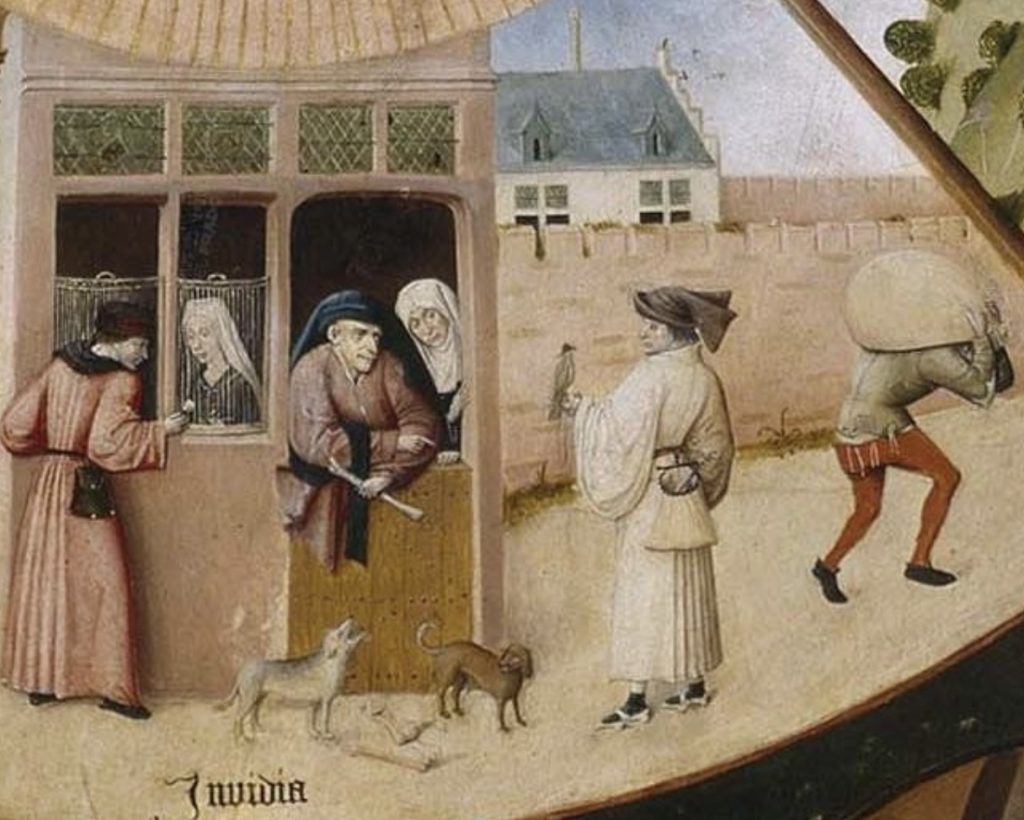
FOur Last ThiNgs
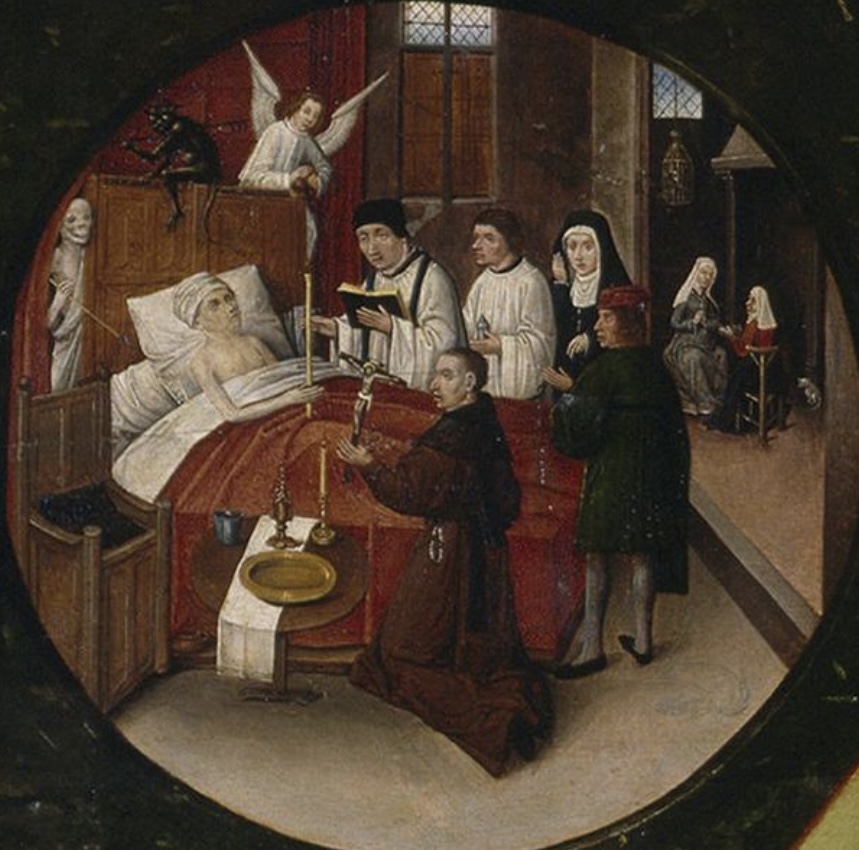
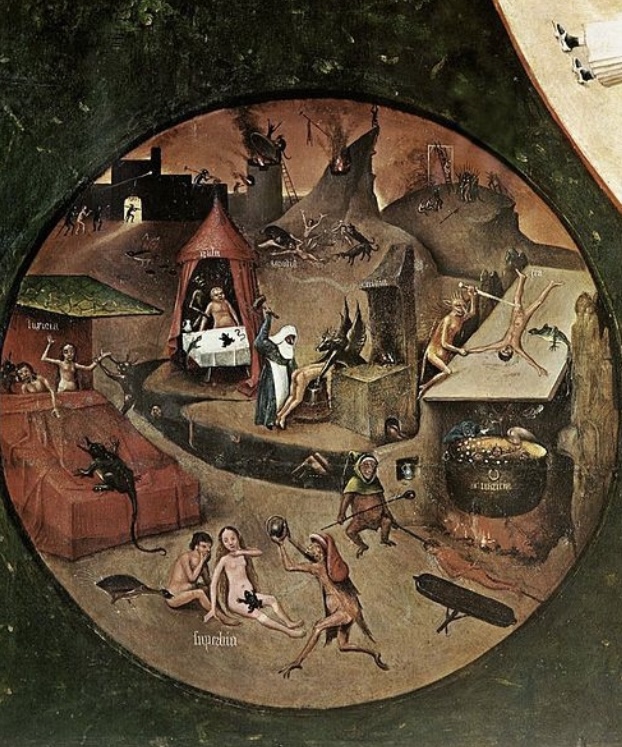
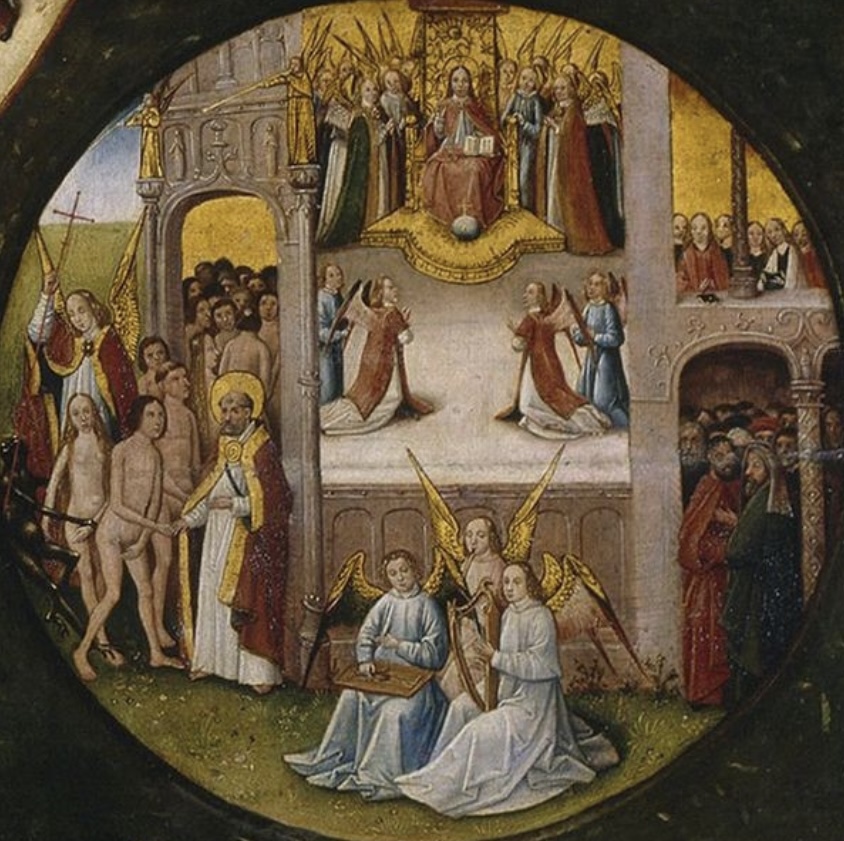
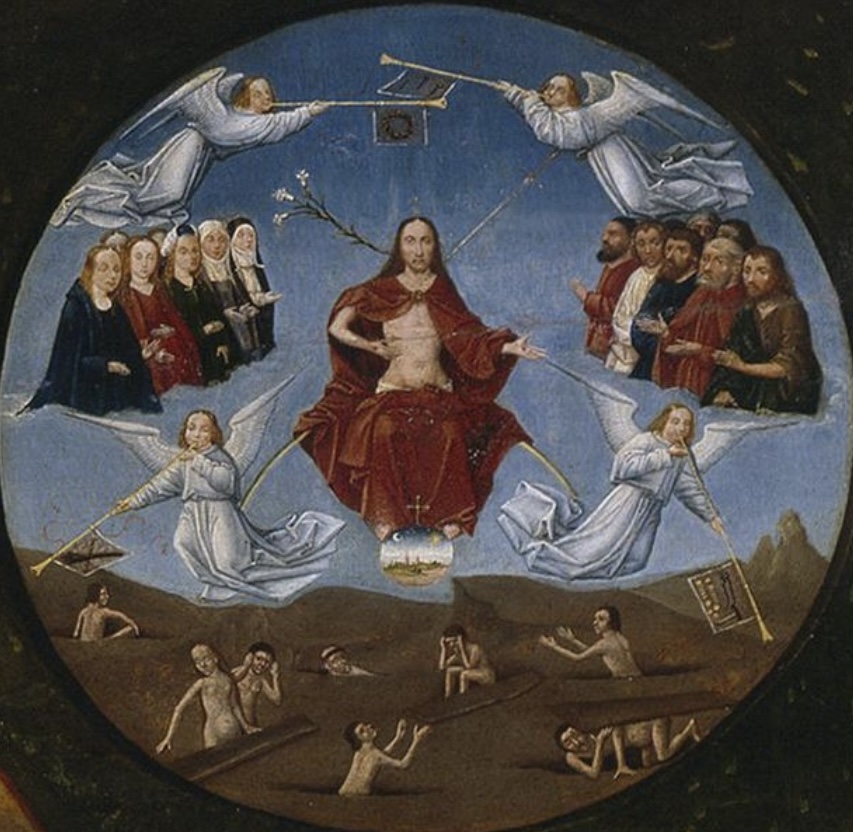
Each scene of the painting depicts a different sin.
In the Pride scene, a demon is shown holding a mirror in front a woman. In anger, a man is about to kill a woman symbolizing murder as an effect of Wrath.
The small circles also have details. In Death of Sinner, death is shown at the doorstep along with an angel and a demon while the priest says the sinner’s Last Rites.
In Glory, the saved are entering Heaven, with Jesus and the Saints, at the gate of Heaven an Angel prevents a demon from ensnaring a woman. Saint Peter is shown as the gatekeeper.
In Judgment, Christ is shown in glory while angels wake up the dead, while in the Hell demons torment sinners according to their sins.
Further examples include Gluttony, where a demon “feeds” a man food of hell. Another example is the Greed scene, in which misers are boiled in a pot of gold.
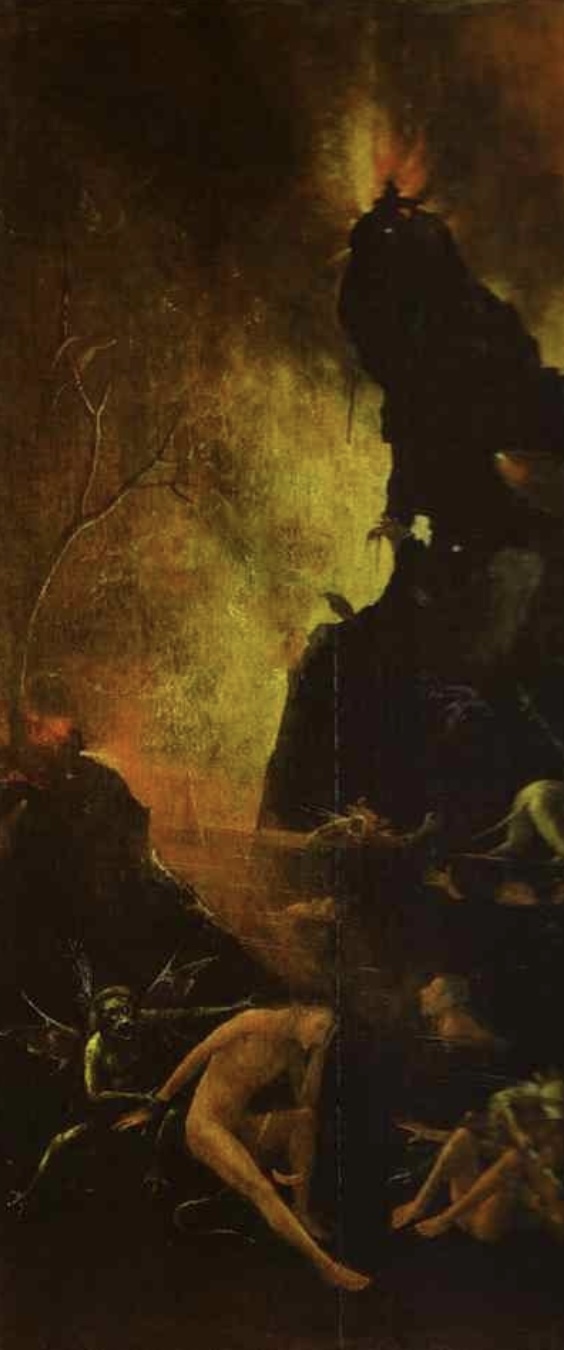
This painting is part of a series of four: the others are Ascent of the Blessed, Terrestrial Paradise and Fall of the Damned. In this panel it shows the punishment of the wicked with diverse kinds of torture laid out by demons.

Death and the Miser is a Hieronymus Bosch painting. It is currently in the National Gallery of Art in Washington, D.C., USA. The painting is the inside of the right panel of a divided triptych. The other existing portions of the triptych are The Ship of Fools and Allegory of Gluttony and Lust, while The Wayfarer was painted on the external right panel.
Death and the Miser belongs to the tradition of the memento mori, works that remind the viewer of the inevitability of death. The painting shows the influence of popular 15th-century handbooks on the art of dying (Ars moriendi), intended to help Christians choose Christ over sinful pleasures. As Death looms, the miser, unable to resist worldly temptations, reaches for the bag of gold offered by a demon, even while an angel points to a crucifix from which a slender beam of light descends.
There are references in the painting to dichotomous modes of life. A crucifix is set on the only (small) window of the room. A thin ray of light is directed down to the bottom of the large room, which is darkened. A demon holding an ember lurks over the dying man, waiting for his hour. Death is dressed in flowing robes that may be a subtle allusion to a prostitute’s garb. He holds an arrow aimed at the miser’s groin, which indicates that the dying man suffers from a venereal disease, which itself may be associated with a love of earthly pleasures.
In the foreground, Bosch possibly depicts the miser as he was previously, in full health, storing gold in his money chest while clutching his rosary. Symbols of worldly power such as a helmet, sword and shield allude to earthly follies — and hint at the station held by this man during his life, though his final struggle is one he must undergo naked, without arms or armor. The depiction of such still-life objects to symbolize earthly vanity, transience or decay would become a genre in itself among 17th-century Flemish artists.
Whether or not the miser, in his last moments, will embrace the salvation offered by Christ or cling to his worldly riches, is left uncertain.
